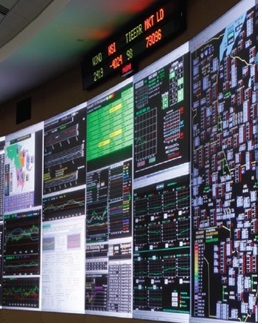The electric grid contains many mysteries, and we will have to master many of these to reduce carbon emissions. Fortunately, the independent grid operators are increasingly pulling back the curtain on renewable energy and coal plant retirements. And the view is great!
Keeping the lights on with wind and solar
Grid operators have vast data and computing resources that they use to make sure the lights stay on every minute of every day. They can use — and increasingly are using — these same resources to forecast future grid needs and costs with reduced carbon emissions. This past week, the Midcontinent Independent System Operator (ISO) revealed modeling details for a future electricity supply with more renewable energy, less coal, and 23% less CO2 with only a 1% increase in generation costs over 25 years. The Midcontinent ISO operates the wholesale power grid from Manitoba to Louisiana.
This is the latest in a series of analyses by the folks that actually operate the grid revealing the minimal costs and enormous benefits of a big shift to wind and solar for electric power. A renewable energy study released recently by PJM, the system operator for the Ohio Valley and mid-Atlantic states, shows that 30% of energy could come from wind and solar, with CO2 savings as high as 40%, and only a 2% increase in reserves necessary to keep the lights on. That is amazingly cheaper and easier than all the critics of renewable energy have claimed.
These guys have the data
Grid operators have sufficient details on the efficiency, fuel needs, and cost to run the power plant fleet for present and future configurations, within the limits of the high-voltage grid. What the Midcontinent ISO did this past week to advance the understanding of carbon regulation was illustrate a “generation shift” with increased coal plant retirements, a 20% renewable energy policy, and an escalating cost of carbon emissions.
With UCS prodding, the illustration for the first time separated out the cost of emitting carbon (based on their assumed cost of carbon), making it clear that the combination of these policies over the next 25 years saves $19 billion (present value) in fuel, and accumulates $113 billion as a fund available for rebate/reinvestment/whatever. The forecasted cost of running the Midcontinent grid is a cumulative net present value of around $250 billion, so making clear that this $113 billion is really an accounting for modeling assumption and not a true fuel cost is really important.
We haven’t yet got an apples-to-apples comparison of the generation shift and the business-as-usual plan that maintains fossil-fuel use at current levels. The Midcontinent ISO has not yet applied a CO2 cost adder to the business-as-usual generation and fuel mix, so policymakers and advocates still have to do some thinking to follow the presentation. When considering the costs and qualities of the future power system, it would make sense to include a carbon price on the business-as-usual mix, which would create a number much higher than the $113 billion because of the greater amount of coal. Or, recognize that this $113 billion is created as the result of a modeling exercise, and the carbon price adder should be excluded in the model results. When we plan for carbon emissions reductions by reducing fossil fuel use, the result is lower costs than burning all that fuel and trying to fix the damage afterward. Switch on the wind and solar.
We’re going to need transparency and clear comparisons as we work to modernize the grid and reduce carbon pollution. Many positive steps add up to progress. Stay tuned, and we’ll report on the next ones.

